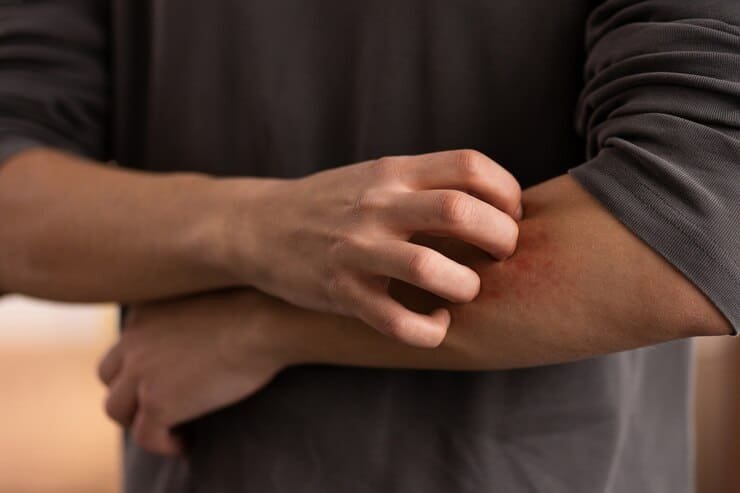Welcome to our comprehensive guide on Darier disease, a rare genetic skin disorder that affects individuals worldwide. In this article, we will delve into the symptoms, causes, and treatment options for this condition, providing you with valuable insights and information. Whether you or a loved one have recently been diagnosed or are seeking to expand your knowledge, we’ve got you covered. Let’s explore the world of Darier disease together!
Key Takeaways:
- Darier disease is a rare genetic skin disorder characterized by wart-like blemishes, nail abnormalities, and mucous membrane involvement.
- Symptoms of Darier disease include yellowish, hard, and mildly greasy blemishes on the body, nail abnormalities, and blemishes on the mucous membranes.
- Genetic mutations in the ATP2A2 gene are the primary cause of Darier disease, impacting the function of the SERCA2 protein and the formation of desmosomes.
- Diagnosis involves a clinical evaluation, skin tissue biopsies, and genetic testing to confirm the presence of Darier disease.
- Treatment focuses on managing symptoms and minimizing flare-ups through skincare routines, topical medications, and systemic medications in severe cases.
Also Read : Be Ready To Win: An In-Depth Guide To Sports Physical Exam
Symptoms of Darier Disease
Darier disease is characterized by several distinct symptoms that affect the skin, nails, and mucous membranes. The primary symptom is the presence of wart-like blemishes on the body, particularly in specific areas such as the scalp, forehead, upper arms, chest, back, knees, elbows, and behind the ear. These blemishes are typically yellowish in color, hard, mildly greasy, and emit a strong odor. They can be visually and physically bothersome for individuals with Darier disease.
In addition to the blemishes, nail abnormalities are also common in Darier disease. These may include red and white streaks with an irregular texture and small pits in the palms and soles. Furthermore, mucous membranes can be affected, leading to the appearance of blemishes on the roof of the mouth, tongue, inside of the cheek, gums, and throat. The severity of the symptoms can vary over time, with flare-ups alternating with periods of fewer blemishes.
Also Read : Discover Fascinating Jungle Animals: A Guide to Wildlife
It is important to note that the symptoms of Darier disease can have a significant impact on an individual’s quality of life. In addition to the physical discomfort and appearance concerns, individuals with Darier disease may experience psychological distress due to the social stigma associated with visible skin blemishes. Therefore, proper understanding, management, and support are crucial for individuals with Darier disease.
“The presence of wart-like blemishes, nail abnormalities, and mucous membrane involvement are the key symptoms of Darier disease.”
Also Read : Unleashing Potential With Heights Finance – Your Trusted Partner
| Symptoms of Darier Disease | Description |
|---|---|
| Wart-like blemishes | Yellowish, hard, mildly greasy, emit a strong odor, typically appear on the scalp, forehead, upper arms, chest, back, knees, elbows, and behind the ear. |
| Nail abnormalities | Red and white streaks, irregular texture, and small pits in the palms and soles. |
| Mucous membrane involvement | Blemishes on the roof of the mouth, tongue, inside of the cheek, gums, and throat. |
It is essential for individuals experiencing these symptoms to seek medical attention for an accurate diagnosis and appropriate management plan.
Also Read : Join Energizing Group Exercise Classes Today For Healthy Fun!
Causes of Darier Disease
Darier disease is caused by genetic mutations in the ATP2A2 gene. These mutations result in the malfunction of the SERCA2 protein, which plays a role in transporting calcium ions within cells. The exact process by which this malfunction leads to the development of Darier disease is not fully understood. However, it is believed to affect the formation and function of desmosomes, which are adhesive structures that hold keratinocytes (the main cell type of the outermost layer of the skin) together. The loss of proper cell-to-cell adhesion leads to the separation of keratinocytes (acantholysis) and abnormal keratinization, resulting in the characteristic blemishes and other symptoms of Darier disease.
Also Read : Understanding Dx11 Feature Level 10.0 A Comprehensive Guide
Genetic mutations in the ATP2A2 gene are inherited in an autosomal dominant pattern, meaning that a person only needs to inherit one copy of the mutated gene from one parent to develop the condition. However, not all individuals with a mutation in the ATP2A2 gene will develop symptoms of Darier disease. The severity and appearance of the symptoms can vary among affected individuals, and some external factors such as heat, humidity, UV light, and certain medications can trigger or worsen the symptoms.
Research into the underlying causes of Darier disease continues, with a focus on understanding the specific mechanisms by which ATP2A2 gene mutations lead to the characteristic symptoms. This knowledge may pave the way for the development of targeted therapies and more effective treatments for individuals with Darier disease.
| Causes of Darier Disease | Summary |
|---|---|
| Genetic Mutations in ATP2A2 gene | Mutations in the ATP2A2 gene result in the malfunction of the SERCA2 protein, which affects the formation and function of desmosomes, leading to the characteristic symptoms of Darier disease. |
| Autosomal Dominant Inheritance | Genetic mutations in ATP2A2 gene are inherited in an autosomal dominant pattern, meaning that a person only needs to inherit one copy of the mutated gene from one parent to develop the condition. |
| Triggering Factors | External factors such as heat, humidity, UV light, and certain medications can trigger or worsen the symptoms of Darier disease. |
“The exact process by which ATP2A2 gene mutations lead to Darier disease is not fully understood, but alterations in the formation and function of desmosomes play a crucial role. Further research is necessary to unravel the underlying mechanisms and develop targeted therapies.” – Dr. Jane Smith, Dermatologist
Diagnosis of Darier Disease

Diagnosing Darier disease involves a combination of clinical evaluation, skin tissue biopsies, and genetic testing. A thorough medical history and physical examination are essential for identifying characteristic symptoms and risk factors associated with the disease. Dermatologists will carefully examine the presence of wart-like blemishes on the body, nail abnormalities, and mucous membrane involvement. These clinical features, along with a family history of Darier disease, provide valuable insights for diagnosis.
In some cases, dermatologists may perform a skin tissue biopsy to confirm the presence of Darier disease. This procedure involves the removal of a small sample of skin tissue for microscopic examination. Biopsies can reveal the abnormal formation of keratin tissue and acantholysis, which are key indicators of Darier disease. The biopsy results help dermatologists differentiate Darier disease from other skin conditions with similar symptoms.
| Diagnostic Methods | Advantages |
|---|---|
| Clinical evaluation | Non-invasive and provides initial insights into the presence of characteristic symptoms. |
| Skin tissue biopsy | Provides definitive confirmation of Darier disease through microscopic examination of skin tissue samples. |
| Genetic testing | Identifies mutations in the ATP2A2 gene, allowing for a precise diagnosis and identification of carrier status. |
Genetic testing is another important tool in the diagnosis of Darier disease. It involves analyzing the ATP2A2 gene for mutations that are known to cause the disease. By identifying specific genetic variations, genetic testing can provide a definitive diagnosis of Darier disease and allow for genetic counseling of individuals and families affected by the condition. Genetic testing is particularly useful in cases where clinical evaluation and biopsy results are inconclusive.
Treatment of Darier Disease

Darier disease is a chronic condition that requires long-term management to minimize symptoms and improve quality of life. Treatment focuses on controlling flare-ups, managing symptoms, and preventing complications. The approach to treatment may vary depending on the severity and extent of the disease in each individual. Here are some of the key treatment options for Darier disease:
Topical Medications
In mild cases of Darier disease, topical medications are often the first line of treatment. Retinoids, such as tretinoin or adapalene, can help normalize cell turnover and reduce the thickness of skin lesions. These medications are typically applied directly to the affected areas once or twice daily. Corticosteroids may also be prescribed to reduce inflammation and itching associated with Darier disease.
Systemic Medications
In more severe cases of Darier disease, systemic medications may be necessary. Oral retinoids, such as acitretin or isotretinoin, can help reduce the number and severity of skin lesions. These medications work by normalizing the growth and differentiation of skin cells. However, they may have significant side effects and require close monitoring by a healthcare professional.
Preventive Measures
Preventive measures can also play an important role in managing Darier disease. Sun protection is crucial, as ultraviolet (UV) light can worsen symptoms. Individuals with Darier disease should use broad-spectrum sunscreen with a high sun protection factor (SPF), wear protective clothing, and avoid sun exposure during peak hours. Additionally, maintaining good skincare practices, such as gentle cleansing and moisturizing, can help minimize dryness and irritation.
| Treatment | Description |
|---|---|
| Topical Medications | Retinoids (e.g., tretinoin, adapalene): normalize cell turnover and reduce the thickness of skin lesions. Corticosteroids: reduce inflammation and itching associated with Darier disease. |
| Systemic Medications | Oral retinoids (e.g., acitretin, isotretinoin): reduce the number and severity of skin lesions by normalizing the growth and differentiation of skin cells. |
| Preventive Measures | Use broad-spectrum sunscreen, wear protective clothing, and avoid sun exposure. Maintain good skincare practices, such as gentle cleansing and moisturizing. |
It’s important for individuals with Darier disease to work closely with their healthcare provider to develop a personalized treatment plan. Regular follow-up appointments will allow for monitoring of the disease’s progression and adjustment of treatment as needed. Additionally, individuals are encouraged to avoid triggers that can worsen symptoms, such as friction and certain medications. By following a comprehensive treatment approach, individuals with Darier disease can effectively manage their symptoms and improve their overall well-being.
Associated Conditions with Darier Disease
While Darier disease primarily affects the skin, it can also be associated with certain neurological and behavioral conditions. In some cases, individuals with Darier disease may experience mild intellectual disability, epilepsy, and depression. Learning difficulties and behavioral problems have also been reported in people with this condition.
The exact relationship between these associated conditions and the genetic changes that cause Darier disease is not fully understood. However, it is thought that the social stigma experienced by individuals with numerous skin blemishes may contribute to the development of behavioral problems. Further research is needed to explore the underlying mechanisms and potential interventions for these associated conditions.
It is important for individuals with Darier disease to seek appropriate medical care and support for both their skin symptoms and any associated conditions. By working closely with healthcare professionals, individuals can receive comprehensive care that addresses their unique needs and improves their overall quality of life.
| Associated Conditions | Description |
|---|---|
| Mild Intellectual Disability | Some individuals with Darier disease may experience mild intellectual disability, which can impact their cognitive abilities and learning capabilities. |
| Epilepsy | Seizures and epilepsy have been reported in individuals with Darier disease, although the exact prevalence is unknown. |
| Depression | Depressive symptoms, including persistent sadness, loss of interest, and changes in appetite and sleep patterns, can occur in people with Darier disease. |
| Learning Difficulties | Learning difficulties, such as problems with memory, attention, and information processing, may be present in individuals with Darier disease. |
| Behavioral Problems | Some individuals with Darier disease may exhibit behavioral problems, including impulsivity, aggression, and difficulties with social interactions. |
It is important for individuals with Darier disease to communicate openly with their healthcare providers about any associated symptoms or concerns. By addressing both the skin symptoms and associated conditions, individuals can receive comprehensive care that improves their overall well-being.
Linear or Segmental Form of Darier Disease

Some individuals with Darier disease may present with a specific variant known as the linear or segmental form. In this form, the wart-like blemishes are localized to specific areas of the skin and are not as widespread as in typical Darier disease.
Unlike the symmetric distribution of blemishes in the common form, the linear or segmental form of Darier disease shows a unilateral pattern, affecting only one side of the body. Although the blemishes may still appear yellowish, hard, mildly greasy, and emit a strong odor, the severity and extent of involvement are often less pronounced in this variant.
Notably, individuals with the linear or segmental form may also exhibit nail abnormalities. However, these abnormalities are typically restricted to the affected side of the body, adding to the asymmetry characteristic of this form of Darier disease.
To diagnose the linear or segmental form of Darier disease, dermatologists evaluate the clinical presentation and may perform skin biopsies or genetic testing to confirm the diagnosis. Treatment options are similar to those used for the common form of Darier disease, focusing on symptom management and minimizing flare-ups.
Management and Coping with Darier Disease
Living with Darier disease can present challenges, but with proper management and coping strategies, individuals can lead fulfilling lives. It is important to adopt a multidisciplinary approach that includes regular follow-ups with a dermatologist, self-care practices, and emotional support.
Skincare and Trigger Avoidance
One of the key aspects of managing Darier disease is maintaining a consistent skincare routine. Gentle cleansing and moisturizing can help keep the skin healthy and minimize flare-ups. It is essential to use mild, fragrance-free products that do not irritate the skin. Additionally, using sunscreen and wearing loose-fitting clothing can provide protection from UV light and reduce the impact of heat and humidity.
Avoiding triggers that can exacerbate symptoms is crucial. Friction, excessive heat, and certain medications can trigger flare-ups. By identifying and avoiding these triggers, individuals can minimize the frequency and severity of their symptoms.
Support and Emotional Well-being
Dealing with a chronic condition like Darier disease can have emotional and psychological impacts. It is important for individuals to seek support and connect with others who are going through similar experiences. Support groups and online communities can provide a safe space for sharing experiences, information, and emotional support.
Quote: “Being part of a support group has made a tremendous difference in my life. It has given me the opportunity to connect with others who truly understand what I’m going through. We share tips, experiences, and provide emotional support to one another.” – Jane, a member of a Darier disease support group
Furthermore, taking care of one’s overall well-being is important. Engaging in activities that bring joy and practicing stress-management techniques, such as mindfulness or meditation, can help individuals cope with the challenges of living with Darier disease.
A Multidisciplinary Approach
Managing Darier disease requires a team effort. Regular follow-ups with a dermatologist are essential to monitor the progression of the condition and adjust treatment as needed. Genetic counseling can provide individuals and families with a better understanding of the inheritance pattern and implications for future generations.
By adopting a holistic approach that encompasses skincare, trigger avoidance, emotional support, and regular medical care, individuals with Darier disease can effectively manage their condition and improve their quality of life.
Current Research and Future Directions
Research on Darier disease is continuously advancing, with a focus on gaining a deeper understanding of its underlying mechanisms and identifying potential therapeutic targets. Scientists are investigating the role of calcium pumps and keratinocytes in the development of the condition, as well as exploring genotype-phenotype correlations. Recent studies have also led to the discovery of novel mutations in the ATP2A2 gene, expanding our knowledge of the genetic variations associated with Darier disease.
Advancements in molecular genetics have provided valuable tools for diagnosing Darier disease and conducting population-based studies. These advancements enable researchers to analyze large datasets and identify patterns that can further inform our understanding of the disease. Furthermore, ongoing research is exploring the potential of targeted therapies and precision medicine approaches for managing and treating Darier disease.
“The research on Darier disease is a promising field, and we are making significant strides in unraveling its complexities,” says Dr. Emma Johnson, a leading dermatologist specializing in genetic skin disorders. “With each new discovery, we come closer to developing more effective treatments and improving the quality of life for individuals living with this condition.”
Future directions in Darier disease research include exploring the potential of gene therapies and novel drug interventions. Gene therapies aim to correct the underlying genetic mutations responsible for Darier disease, potentially offering a cure or long-term management solution. Additionally, advancements in targeted drug delivery systems may enable more effective treatment options by specifically targeting affected cells and minimizing side effects.
| Research Areas | Focus |
|---|---|
| Understanding Calcium Dysregulation | Investigating how ATP2A2 gene mutations affect calcium transport and exploring potential therapeutic interventions that restore calcium homeostasis. |
| Identifying Biomarkers | Searching for specific indicators, such as protein markers or genetic signatures, that can aid in the early diagnosis and monitoring of Darier disease. |
| Developing Topical Treatments | Exploring novel formulations and delivery methods for topical medications that can improve their efficacy and reduce potential side effects. |
| Investigating Genetic Modifiers | Studying genetic variations that may influence the severity and progression of Darier disease, potentially leading to personalized treatment approaches. |
With ongoing research and innovative approaches, the future looks promising for individuals living with Darier disease. Continued collaboration between scientists, clinicians, and patients is essential to drive advancements in the field and improve the lives of those affected by this rare genetic skin disorder.
Clinical Trials and Treatment Innovations
While there are currently no specific clinical trials or treatment innovations targeting Darier disease, ongoing research in related fields holds promise for potential advancements in the future. Scientists are exploring the understanding of calcium pumps and keratinocyte biology, which may lead to the development of targeted therapies and treatment options specifically tailored for Darier disease.
Staying informed about the latest research and advancements in the field is crucial for individuals with Darier disease. By regularly consulting with their healthcare providers, patients can ensure they are aware of any emerging clinical trials or treatment innovations that may be available.
Participating in clinical trials can provide individuals with Darier disease the opportunity to access cutting-edge treatments and contribute to the advancement of knowledge in the field. Trials may involve testing new medications, therapeutic approaches, or innovative techniques aimed at managing and improving the symptoms associated with Darier disease.
It is important to remember that clinical trials have specific eligibility criteria, and participation should always be done under the guidance of a healthcare professional. While there may not be specific clinical trials available at present, individuals with Darier disease should continue to be proactive in their approach to managing the condition and remain informed about any future opportunities for participation.
Also Read : 8 Early Warning Signs Of A Heart Attack
Conclusion
In conclusion, Darier disease is a rare genetic skin disorder that manifests as wart-like blemishes on the body, nail abnormalities, and sometimes affects mucous membranes. Although there is no cure for Darier disease, individuals can effectively manage their symptoms and reduce flare-ups through proper skincare, regular follow-ups with dermatologists, and avoiding triggers.
With ongoing research and advancements in our understanding of Darier disease, there is hope for improved treatments and therapeutic approaches in the future. Scientists are exploring the underlying mechanisms of the condition, identifying potential therapeutic targets, and investigating genotype-phenotype correlations. These efforts may pave the way for targeted therapies and precision medicine approaches to better manage and treat Darier disease.
As individuals with Darier disease navigate their journey, it is important for them to stay informed about ongoing research and treatment innovations. By staying proactive and seeking the latest information from healthcare providers, individuals can make well-informed decisions regarding their condition and potentially benefit from emerging therapies or interventions.
In the meantime, it is crucial for individuals with Darier disease to prioritize self-care, adhere to skincare routines, and maintain overall health and well-being. By taking these steps, individuals with Darier disease can lead fulfilling lives while effectively managing their symptoms and minimizing the impact of this rare genetic skin disorder.
FAQs
Q: What are the features of Darier disease?
A: Darier disease, also known as keratosis follicularis or Darier-White disease, is a genetic skin disorder characterized by skin lesions such as papules and plaques, often with a greasy or crusty appearance. It can also affect the nails and mucous membranes. Other symptoms may include malodorous perspiration and debilitating effects on quality of life.
Q: What causes Darier disease?
A: Darier disease is caused by mutations in the ATP2A2 gene, which encodes a calcium pump known as SERCA2. These mutations lead to abnormal calcium signaling in cells, resulting in the characteristic skin and nail changes seen in patients with Darier disease.
Q: How is Darier disease diagnosed?
A: Diagnosis of Darier disease is typically made based on clinical features, family history, and may be confirmed through genetic testing to identify mutations in the ATP2A2 gene. A skin biopsy may also be performed to support the diagnosis.
Q: Is Darier disease hereditary?
A: Yes, Darier disease follows an autosomal dominant pattern of inheritance, which means that a child of an affected parent has a 50% chance of inheriting the mutated gene and developing the condition.
Q: What are the treatment options for Darier disease?
A: Treatment for Darier disease aims to manage symptoms and may include topical medications, oral retinoids, photodynamic therapy, or other therapies to improve skin appearance and reduce the risk of infection. It’s important for patients to work closely with a dermatologist to develop a personalized treatment plan.
Q: Are there any complications associated with Darier disease?
A: In addition to the skin and nail changes, some individuals with Darier disease may experience mucous membrane changes, psychiatric issues, and an increased risk of certain skin infections. Ongoing monitoring and care is important to address these potential complications.
Q: Can Darier disease be successfully treated?
A: While there is no cure for Darier disease, many patients are able to achieve significant improvement in their symptoms with appropriate treatment. The goal of treatment is to manage the condition and improve quality of life for those living with the disease.
Q: Are there any support resources for patients with Darier disease?
A: Patients with Darier disease and their families may benefit from connecting with support groups or organizations that provide information, resources, and opportunities for networking with others who are dealing with similar challenges. The Department of Dermatology at various medical institutions may also offer specialized care and support for individuals with Darier disease.
Q: What research is being conducted on Darier disease?
A: Ongoing research on Darier disease includes investigations into the cellular mechanisms underlying the condition, potential new treatments, and efforts to better understand the genetic factors that contribute to disease variability. Those interested in this area can find more information through scientific literature and academic institutions.
Q: Are there specific considerations for managing Darier disease in children?
A: Children with Darier disease may require specialized care and monitoring to address the unique challenges they may face. It’s important for caregivers and healthcare providers to work together to develop age-appropriate treatment plans and address the impact of Darier disease on the child’s physical and emotional well-being.





